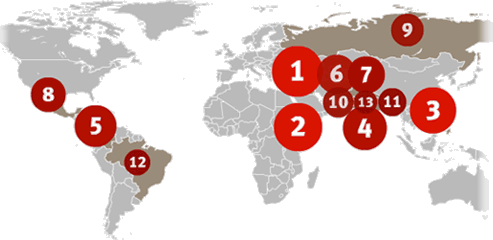Meeting with a CPJ delegation in May, President Asif Ali Zardari committed his government to the pursuit of justice in journalist murders. But with seven journalists killed, five in targeted killings, Pakistan was the world’s deadliest country for the press for the second consecutive year. High-profile investigations into the drive-by shooting of Wali Khan Babar in January and the abduction and fatal beating of Saleem Shahzad in May yielded no prosecutions, replicating the country’s long-standing record of impunity in journalist murders. Intelligence officials were suspected of complicity in the Shahzad case and other anti-press attacks. With Zardari’s government unwilling or unable to protect journalists, media organizations stepped up efforts to protect reporters working in the field. But widespread violence in Baluchistan, the Federally Administered Tribal Areas, Karachi, and the Swat Valley–combined with the war in Afghanistan–made the challenge exceptionally difficult. At least three Pakistani journalists fled into exile during the year.
Pakistan
» Zardari pledges to reverse record of impunity; unpunished killings continue.
» Pakistan remains the world’s deadliest nation for the press; threats and assaults become more common.
Meeting with a CPJ delegation in May, President Asif Ali Zardari committed his government to the pursuit of justice in journalist murders. But with seven journalists killed, five in targeted killings, Pakistan was the world’s deadliest country for the press for the second consecutive year. High-profile investigations into the drive-by shooting of Wali Khan Babar in January and the abduction and fatal beating of Saleem Shahzad in May yielded no prosecutions, replicating the country’s long-standing record of impunity in journalist murders. Intelligence officials were suspected of complicity in the Shahzad case and other anti-press attacks. With Zardari’s government unwilling or unable to protect journalists, media organizations stepped up efforts to protect reporters working in the field. But widespread violence in Baluchistan, the Federally Administered Tribal Areas, Karachi, and the Swat Valley–combined with the war in Afghanistan–made the challenge exceptionally difficult. At least three Pakistani journalists fled into exile during the year.
Analysis: Under Siege, Pakistani Media Look Inward
As journalists continue to be targeted, the government of Asif Ali Zardari has shown itself unable and unwilling to stand up for a free press. Whatever solutions exist will have to be found by people in the profession. Analysis by Bob Dietz
-
10th
Impunity Index ranking -
7
Killed in 2011 -
41
Killed since 1992 -
1
Prosecution after special inquiries -
12,643
Civilian fatalities, 2007-11
Pakistan is one of the world's worst nations in combating deadly anti-press violence, CPJ's Impunity Index shows.
Journalist murders have gone unpunished over the last decade with just one exception, the killing of Wall Street Journal reporter Daniel Pearl in 2002. At least 14 journalist murders have gone unpunished during that time frame.

| 1. Iraq 2. Somalia 3. Philippines 4. Sri Lanka | 5. Colombia 6. Afghanistan 7. Nepal 8. Mexico | 9. Russia 10. Pakistan 11. Bangladesh 12. Brazil | 13. India |
As violence escalated throughout Pakistan, the risks to journalists increased dramatically, CPJ research shows. At least 29 journalists have been killed in Pakistan in direct relation to their work since 2007.
With 41 work-related fatalities, Pakistan is the world's sixth deadliest nation for the press since 1992, CPJ research shows.
1. Iraq: 151
2. Philippines: 72
3. Algeria: 60
4. Russia: 53
5. Colombia: 43
6. Pakistan: 41
7. Somalia: 36
8. India: 27
9. Mexico: 27
10. Afghanistan: 24
Over the past decade, the government has commissioned at least six high-level special investigations into attacks on journalists, CPJ research shows. In only one case, however, has a special inquiry led to a prosecution.
Many investigations, few results:
2002: Daniel Pearl, killed, prosecution brought
2006: Hayatullah Khan, killed, no prosecution
2010: Umar Cheema, attacked, no prosecution
2011: Waqar Kiani, attacked, no prosecution
2011: Wali Khan Babar, killed, no prosecution
Journalists were covering an exceptionally violent story, as shown by data from the Pakistan Institute for Peace, which monitors terrorist attacks and other acts of violence across the country.
